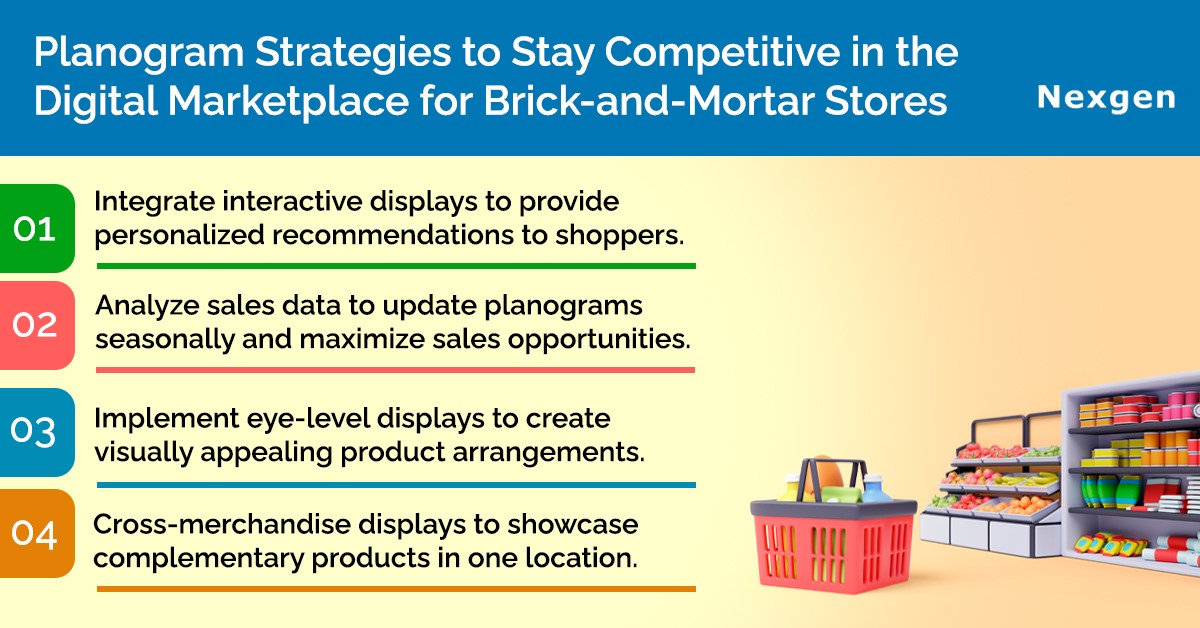In today's increasingly digital world, brick-and-mortar stores face fierce competition from online retailers. With the convenience of online shopping and the growing preference for digital transactions, traditional stores must adapt to stay relevant and competitive. While the digital marketplace presents challenges, it also offers opportunities for brick-and-mortar stores to enhance their presence and attract customers. By strategically leveraging planogram strategies, traditional retailers can enhance their appeal to customers and drive sales. Planograms can be used to optimize shelf space, aisle layouts, and product placement to ensure efficient use of space while still maintaining clear sightlines and easy navigation for customers. Let us explore some effective shelf space planning strategies that brick-and-mortar stores can adopt:

- Digital integration: In today's digital age, brick-and-mortar stores can benefit from integrating digital elements into their planograms. This may include digital signage, interactive displays, or touch-screen kiosks that provide additional product information, promotions, or personalized recommendations to shoppers. By blending physical and digital experiences, retailers can create immersive environments that engage customers and encourage purchase decisions.
- Seasonal and trend-based planograms: Keeping planograms updated with seasonal and trend-based merchandise ensures stores stay relevant and appealing to customers. By regularly refreshing product displays that align with holiday, seasons, or emerging trends, retailers can capture shopper interest and drive impulse purchases. Additionally, analyzing sales data and customer insights can help inform seasonal planogram adjustments to maximize sales opportunities.
- Visual merchandising techniques: Visual merchandising plays a crucial role in capturing the attention of shoppers and driving purchase intent. Brick-and-mortar stores can utilize planograms to implement effective visual merchandising techniques such as color blocking, focal points, and eye-level displays to create visually appealing product arrangements that entice customers to explore and make purchases. By optimizing the layout and presentation of merchandise, retailers can enhance the overall ambiance of the store and elevate the shopping experience.
- Enhance customer experience: Personalized customer experiences can set brick-and-mortar stores apart from their online counterparts. Implementing loyalty programs, offering personalized recommendations based on past purchases, and providing exceptional customer service are essential strategies for fostering customer loyalty and repeat business. Retailers can use planograms to create cross-merchandising displays that showcase related items or accessories, making it convenient for customers to discover and purchase complementary products in one location. This strategy not only enhances the shopping experience but also boosts overall sales and profitability.
- Embrace omnichannel retailing: Brick-and-mortar stores must integrate their offline and online channels seamlessly. By offering omnichannel shopping experiences, retailers can provide customers with options to browse, purchase, and return products through various channels. This approach enhances convenience for customers and allows them to interact with the brand in whichever way suits them best.
Overview of Nexgen POG
Nexgen POG is a robust and user-friendly cloud-based visual merchandising tool. It is designed for quick and efficient planogramming with minimal effort. Planogram in retail can be designed by easily dragging and dropping the products. The multi-device compatibility feature of POG allows you to obtain, share and edit planogram on any device, including your phone. It helps in designing store-specific planograms for increased product visibility and sales.
Get Your Free Trial Now!